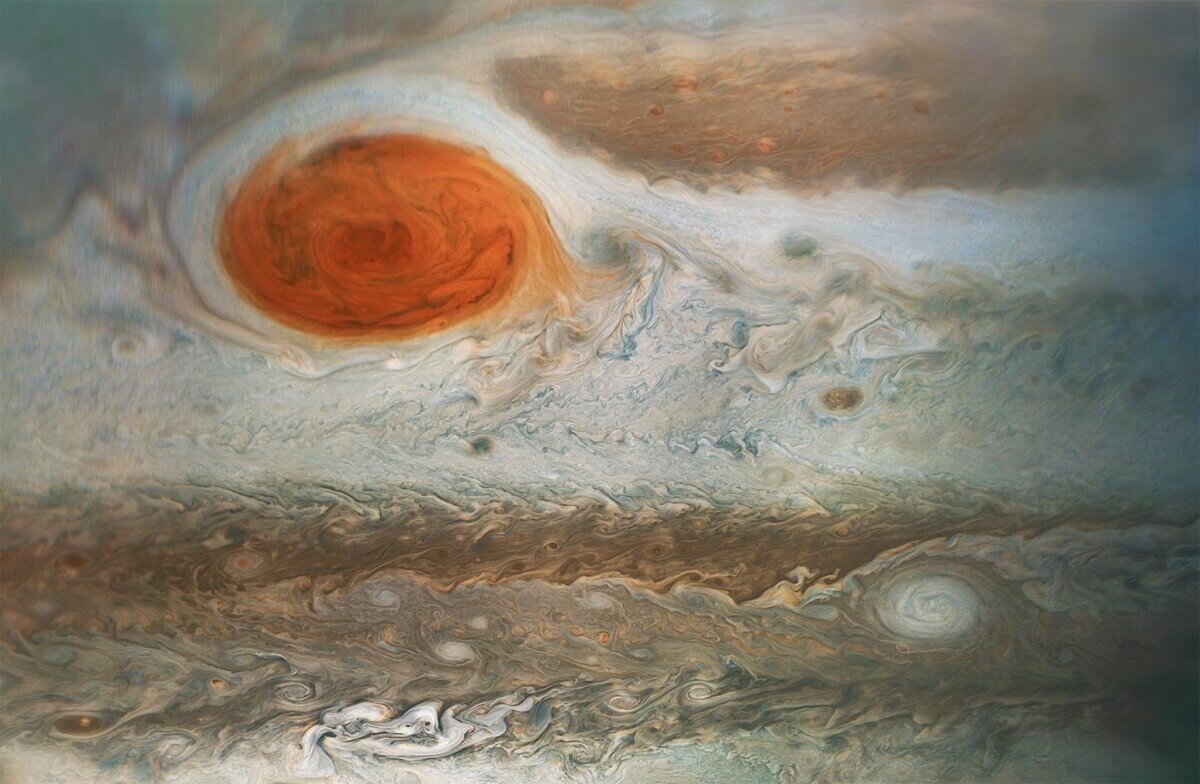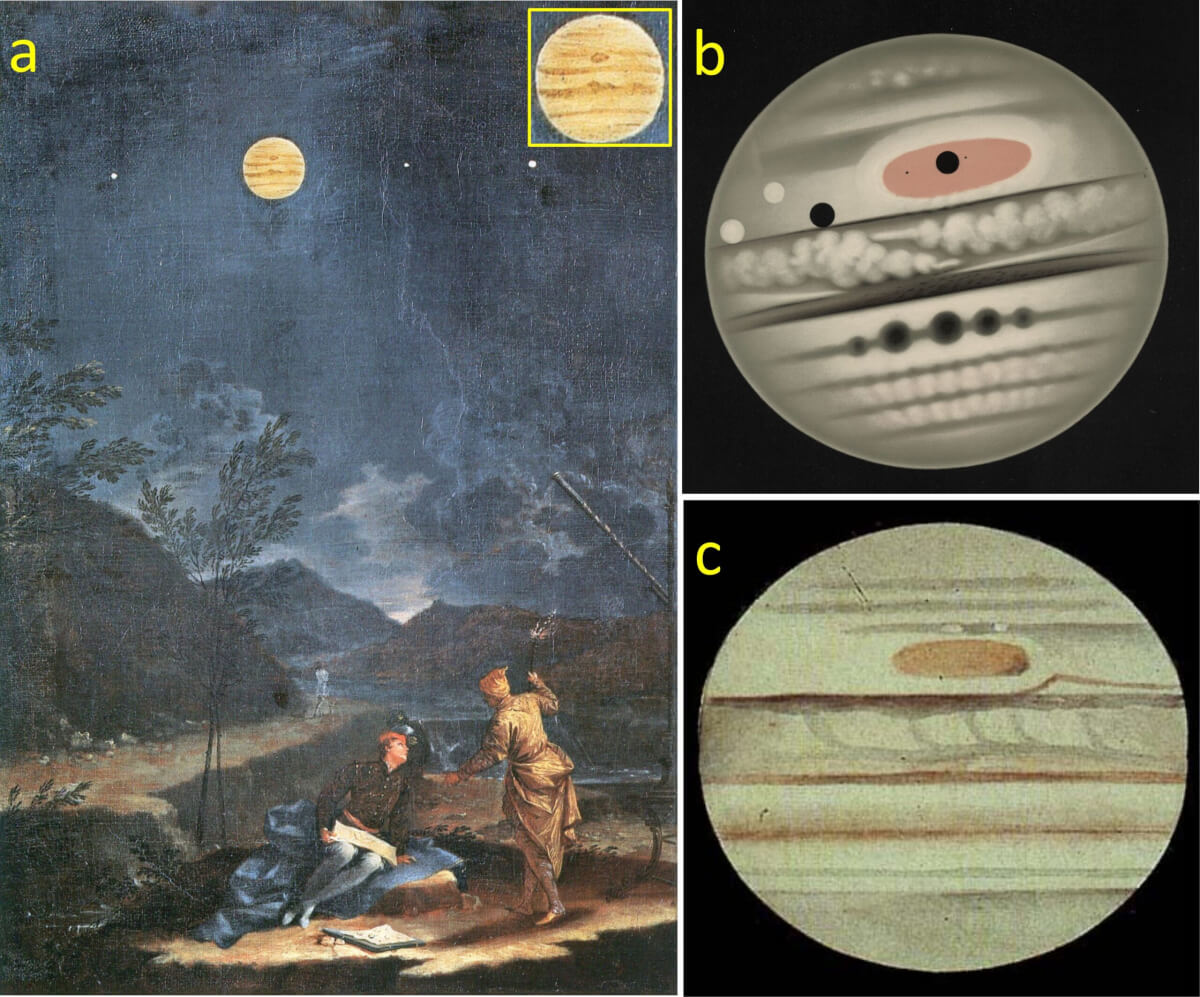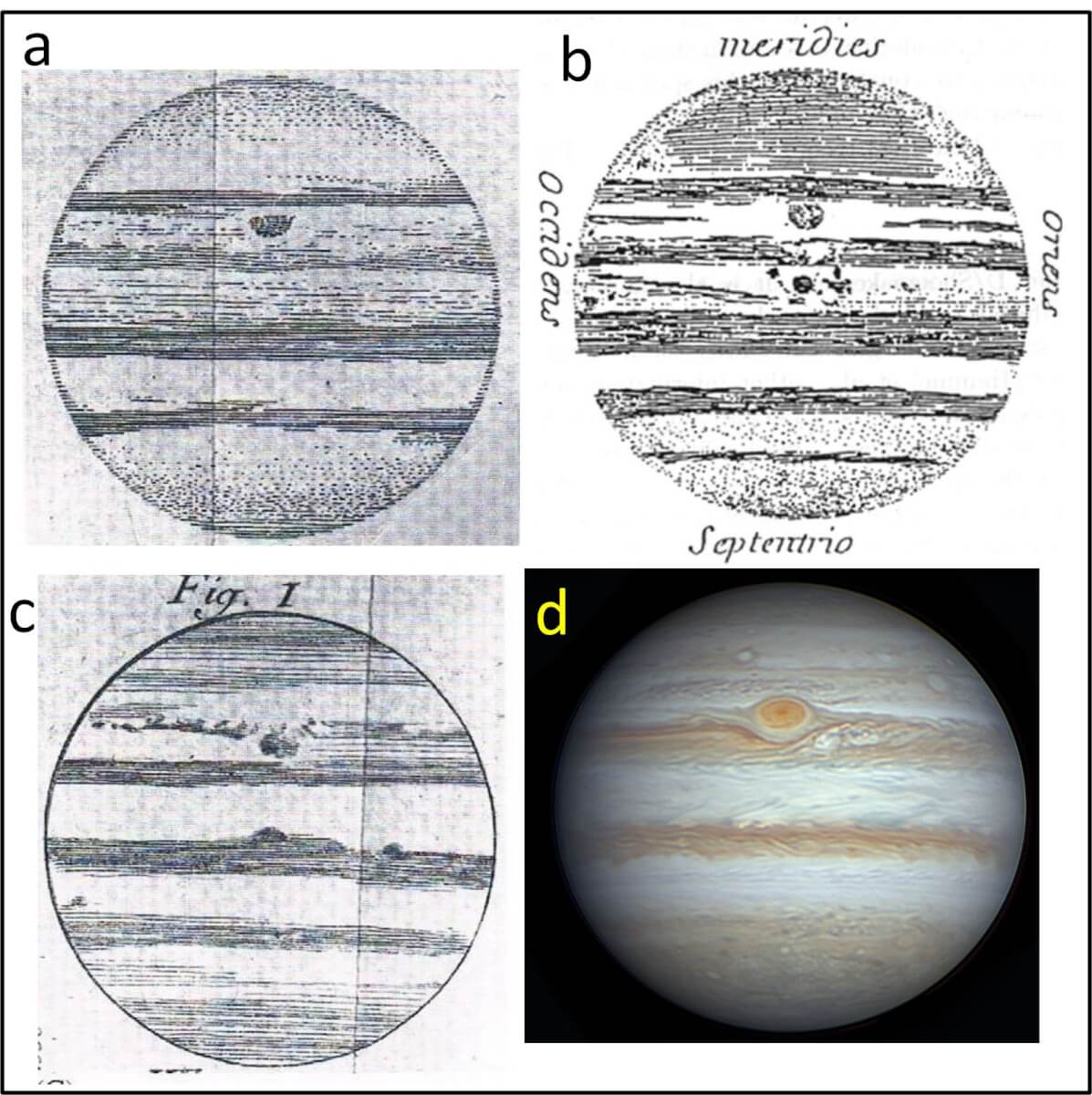
Jupiter’s Great Red Spot, as seen from a Juno flyby in 2018. The Red Spot we see today is likely not the same one famously observed by Cassini in the 1600s, according to a new Geophysical Research Letters paper. Credit: Enhanced Image by Gerald Eichstadt and Sean Doran (CC BY-NC-SA) based on images provided Courtesy of NASA/JPL-Caltech/SwRI/MSSS
WASHINGTON — For nearly 400 years, the swirling red vortex known as Jupiter’s Great Red Spot has captured the attention and imagination of astronomers. But surprising new research suggests this planetary icon is actually not the same one described by Italian astronomer Giovanni Domenico Cassini. A detailed analysis of historical observations dating back to the 1600s reveals that what we now know today as Jupiter’s Great Red Spot may have actually formed in the 19th century and is far smaller than its predecessor.
Back in 1665, Cassini noted a large dark oval feature near the location of today’s Great Red Spot. This blemish, dubbed the “Permanent Spot,” was observed intermittently until 1713. Many assumed this was an early sighting of the Great Red Spot, implying the massive storm had been churning for centuries.
However, in a new paper published in Geophysical Research Letters, a team of astronomers scrutinized measurements of both the Permanent Spot and the Great Red Spot over time. To their surprise, the two spots don’t match up. In the late 1800s, the Great Red Spot was two to three times bigger than the Permanent Spot had been. There are also no recorded observations of either spot for over 100 years between 1713 and 1830. This gap strongly suggests the Permanent Spot had disappeared, and the Great Red Spot is a more recent storm that first flared up in 1831.

What’s more, the Great Red Spot has been steadily shrinking since it was first definitively observed. The researchers found that its length has been decreasing by about 210 kilometers (roughly 130 miles) per year. At this rate, if the Great Red Spot and Permanent Spot were the same storm, the Permanent Spot would have had to grow dramatically in size between 1713 and 1830 to reach the dimensions of the Great Red Spot in the 1800s. There are no observations supporting this, and such growth would be uncharacteristic of Jupiter’s vortices.
“From the measurements of sizes and movements, we deduced that it is highly unlikely that the current Great Red Spot was the ‘Permanent Spot’ observed by Cassini,” adds research leader Agustín Sánchez-Lavega, a planetary scientist at the University of the Basque Country, in a media release. “The ‘Permanent Spot’ probably disappeared sometime between the mid-18th and 19th centuries, in which case we can now say that the longevity of the Red Spot exceeds 190 years.”
Methodology: How Did Scientists Tell These Storms Apart?
To reach these conclusions, the researchers carefully combed through centuries of historical records, notes, and drawings from past astronomers. They compiled as many measurements as possible of the size and position of both the Permanent Spot and the Great Red Spot.
For the earliest records of the Permanent Spot between 1665 and 1713, the researchers analyzed drawings from Giovanni Cassini and others. Precise measurements were difficult due to the limitations of early telescopes, but they were able to approximate the spot’s dimensions. They then compared these to more detailed records of the Great Red Spot starting in the 1800s, including drawings, photographs starting in 1879, and modern digital images.
For each observation, the researchers carefully measured the east-west length and north-south width of the spots. When photographs weren’t available, they analyzed astronomers’ drawings, accounting for potential inaccuracies. They also tracked the longitude of the spots over time to calculate their drift rate and velocity. By compiling data points across 350+ years, they could chart long-term trends in the spots’ size and motion.

Results: Astronomers Have Identified 2 Historic Storms
The data shows the Permanent Spot observed by Cassini was significantly smaller than the Great Red Spot, by a factor of two to three times in length. The Great Red Spot’s length has decreased at an average rate of 0.18° per year (207 km/yr) since the 1800s. Its width has also steadily shrunk by about 0.03° per year (36 km/yr).
Extrapolating back in time, these trends indicate the Permanent Spot couldn’t have evolved into the Great Red Spot without an unprecedented period of rapid growth in the 1700s. No such growth was ever documented. The spots also had different drift velocities, further implying they were separate storms.
The Permanent Spot drifted by about 10-6 m/s, whereas the Great Red Spot moved at 4-1 m/s. This could be due to the spots being centered at slightly different latitudes and, therefore, carried along by different wind speeds. However, based on the size and velocity data, the two spots don’t appear to be the same storm separated by a dormant period but rather two independent weather systems.
Study Limitations
This research required cobbling together very limited historical data, so there is inherent uncertainty, especially in the oldest records. Measurements from the 1600s-1700s came from astronomers’ drawings, which, even if well-crafted, are less precise than modern photographs. The gap in observations from 1713-1830 also leaves the fate of the Permanent Spot ambiguous.
Additionally, variations in the Great Red Spot’s color and contrast over time made defining its exact borders difficult in some images. The researchers had to approximate boundary lines, adding some imprecision. Further studies could better constrain observation errors.
Finally, this study focused solely on the spots’ horizontal dimensions. Their vertical structures, which could provide clues about their origins and dynamics, remain poorly understood and warrant investigation with newer 3D modeling techniques.
Takeaways: Jupiter Has Evolved More Than We Thought
So, if the Great Red Spot isn’t as old as we thought, what birthed this brilliant blemish? The study suggests the nascent Great Red Spot may have formed from a disturbance in Jupiter’s turbulent atmosphere, perhaps when a series of smaller vortices merged or from an upwelling “superstorm.” Over subsequent decades, the spot likely became more compact and began spinning faster, turning into the persistent, high-contrast oval we know today.
These findings paint a picture of a more dynamic, evolving Jupiter than typically imagined. While still ancient by human standards, Jupiter’s most famous feature now appears to be centuries, not millennia, old. And it won’t last forever. Continued shrinking might cause the Great Red Spot to disappear within our lifetimes.
“It has been very motivating and inspiring to turn to the notes and drawings of Jupiter and its Permanent Spot made by the great astronomer Jean Dominique Cassini, and to his articles of the second half of the 17th century describing the phenomenon,” Sánchez-Lavega concludes. “Others before us had explored these observations, and now we have quantified the results.”
StudyFinds Editor Chris Melore contributed to this report.










